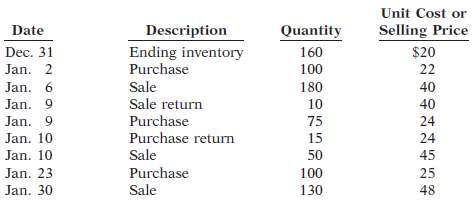Singer Inc. is a retailer operating in Edmonton, Alberta. Singer uses the perpetual inventory method. All sales
Question:
Singer Inc. is a retailer operating in Edmonton, Alberta. Singer uses the perpetual inventory method. All sales returns from customers result in the goods being returned to inventory. (Assume that the inventory is not damaged.) Assume that there are no credit transactions; all amounts are settled in cash. You are provided with the following information for Singer Inc. for the month of January 2012.

Instructions(a) For each of the following cost flow assumptions, calculate(i) Cost of goods sold,(ii) Ending inventory, and(iii) Gross profit.(1) LIFO. (Assume sales returns had a cost of $20 and purchase returns had a cost of $24.)(2) FIFO. (Assume sales returns had a cost of $20 and purchase returns had a cost of $24.)(3) Moving-average. (Round cost per unit to three decimal places.)(b) Compare results for the three cost flowassumptions.
Step by Step Answer:

Financial Accounting Tools for business decision making
ISBN: 978-0470534779
6th Edition
Authors: Paul D. Kimmel, Jerry J. Weygandt, Donald E. Kieso





